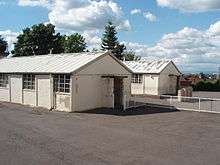F. Pratten and Co Ltd
F. Pratten and Co Ltd, commonly known as Prattens, was a company based on a site in Midsomer Norton and Westfield, Somerset that manufactured prefabricated buildings, most notably portable classrooms that were widely used after the second world war and became synonymous with the company name. The company was founded in 1912 and was acquired by Beazer in 1980, finally ceasing trading in 1993.
Foundation and early years

The company was founded in 1912 by Frank Pratten, a coal miner's son[1] from Westfield,[2] near Radstock, Somerset,[3] then aged around 26.[4] He had previously worked for another local firm, W. Edgell, but acquired a small building off Charlton Road, Midsomer Norton, and formed his own company making prefabricated sheds and other buildings with a Mr. Frank Bourne. There are indications that the new company then manufactured items such as ammunition sheds for the first world war effort. After the war, Frank's brothers Ernest and Bertram joined the company. The economic decline during the inter-war years made low-cost prefabricated buildings attractive to individuals and institutions and the company continued to grow. In the late 1920s Mr Halvor Angle was appointed to lead on advertising, for which he had responsibility for forty years.[5]
Founder Frank Pratten was the father-in-law of cricketer Louis Powell who married his daughter Nora at the Church of St John the Baptist, Midsomer Norton in 1935.[6] Frank died suddenly aged 55 in December 1941.[7]
During World War II, in common with many other factories, the company took on female factory workers to cover the shortfall left by men joining the armed forces.[8]
Post-war boom

The raising of the school leaving age in the UK to 15 in 1945 prompted the government HORSA programme (Hutting Operation for the Raising of the School-Leaving Age). Later the increase to 16 in 1972 prompted ROSLA (Raising of School Leaving Age) classroom 'blocks'. Both age increases generated huge demand for prefabricated 'hut' classrooms.[9] The Pratten name became synonymous with such prefabricated classrooms. Their expected lifespan was twenty-five years[10] but many have been used well beyond this period and some examples from the 1950s - 1970s are still in use. Many schools still refer to their surviving “Pratten huts” and “prattens”, with the company name sometimes even retained in the name the school gives to the building.[11][12][13][14]
As well as the prefabricated classrooms for which it became famous the company manufactured sheds, greenhouses, office units and garages. Its products were exported throughout the world.[15][16]
In 1968 the company was employing 250 staff. The factory was noted to be "completely mechanised in spite of being housed in old buildings".[17]
Final years
The company remained a family business run by the Prattens until 1980 when it was sold to building firm Beazer. This heralded a period of decline in the acquired business's fortunes, and the factory in Charlton Road, Midsomer Norton,[18] was demolished in 1994 with the site being sold for housing development.[19]
Legacy

The company name lives on in a row of housing named Pratten Terrace, built on what was the entrance to the site of the factory. The Timbers, a modern housing estate opposite the former site, is another echo of the company's carpentry origins and tradition.
Two clubs originally founded in association with the company still survive, Prattens Sports and Social Club, and Prattens Bowls Club, both located in Charlton Lane near the original factory site.
The sports and social club previously supported a West Country Carnival club, Prattens Carnival Club, that continued for some years after the company closed but is now disbanded.[20]
The bowls club was started in 1928 by Mr Thomas, a cashier at Prattens, and was built using voluntary labour. For many years it was a male-only membership and the men had to be employed by Prattens to be eligible to play. Now membership of both clubs is open to all.[21]
Later the bowls club was the site of a fatal ballooning accident in 2011.[22]
An original Pratten hut is now used as a community centre and live entertainment venue on the site of the Warminster Athenaeum.[23][24]
External links
- Photograph of Prattens factory in Midsomer Norton from the air, 1933: http://www.britainfromabove.org.uk/image/EPW041215"
- Photographs of the exterior of the surviving Pratten hut at Athenaeum, Warminster, http://www.dannyhowell.net/2015/09/the-pratten-hut-warminster.html and its interior: https://www.flickr.com/photos/warminster-athenaeum-centre/16070541002/in/album-72157649799402586/
- Photograph taken in 1976 of vintage Pratten hen hut and maker's plate: https://locksands.wordpress.com/tag/pratten/
References
- ↑ http://wc.rootsweb.ancestry.com/cgi-bin/igm.cgi?op=GET&db=pjc4ax&id=I23387
- ↑ http://wc.rootsweb.ancestry.com/cgi-bin/igm.cgi?op=GET&db=pjc4ax&id=I23387
- ↑ http://www.genesreunited.co.nz/record?recordid=gbc%2f1891%2f0013332669
- ↑ http://www.genesreunited.co.nz/searchbna/viewrecord/bl/0000515/19411213/093/0014?confirmed=1 Bath Weekly Chronicle and Herald, retrieved 1 April 2016
- ↑ http://www.blurb.co.uk/books/617112-they-started-making-sheds
- ↑ Bath Weekly Chronicle and Herald, 4th May 1935, retrieved 31 March 2016 via http://www.genesreunited.co.nz/searchbna/viewrecord/bl/0000514/19350504/057/0014?confirmed=1
- ↑ http://www.genesreunited.co.nz/searchbna/viewrecord/bl/0000515/19411213/093/0014?confirmed=1 Bath Weekly Chronicle and Herald, retrieved 1 April 2016.
- ↑ http://www.westerndailypress.co.uk/Life-Mary-Moon/story-12333049-detail/story.html
- ↑ http://eprints.ioe.ac.uk/11845/
- ↑ http://www.publications.parliament.uk/pa/cm200102/cmhansrd/vo011122/debtext/11122-32.htm
- ↑ http://www.bbc.co.uk/history/domesday/dblock/GB-320000-135000/page/3
- ↑ http://history.wiltshire.gov.uk/community/getschool.php?id=1030
- ↑ http://www.educationandtraining.org.uk/schools/school/pratten-hut-st-dunstan-school/
- ↑ http://www.findmyschool.co.uk/schooldetails.aspx?id=79918
- ↑ "Former staff gather for book launch". Western Daily Press. 21 April 2009. Retrieved 28 March 2016.
- ↑ "F. Pratten and Co". Grace's Guide. Retrieved 28 March 2016.
- ↑ http://files.eric.ed.gov/fulltext/ED035219.pdf
- ↑ "F. Pratten & Co Horticultural Builders Works and Norton Hill Colliery,". Britain From Above. Historic England. Retrieved 28 March 2016.
- ↑ Norbury, S. G. (17 November 2014). "The History of F. Pratten Co Ltd talk on Thursday". Somerset Guardian. Retrieved 28 March 2016.
- ↑ http://madforcarnivals.weebly.com/p-q-r1.html
- ↑ http://www.prattensbowlsclub.co.uk/history.htm
- ↑ "Two killed in hot air balloon crash in Somerset". BBC. Retrieved 28 March 2016.
- ↑ https://www.google.co.uk/search?q=pratten+hall+warminster+athenaeum&espv=2&biw=1366&bih=667&source=lnms&tbm=isch&sa=X&ved=0ahUKEwiYmu3qq8bMAhVhK8AKHTPHCw8Q_AUICCgD#tbm=isch&q=pratten+hut+warminster+athenaeum&imgrc=rNL111XD-nr3vM%3A
- ↑ http://www.theath.org.uk/
Coordinates: 51°16′35″N 2°28′19″W / 51.2764°N 2.4720°W